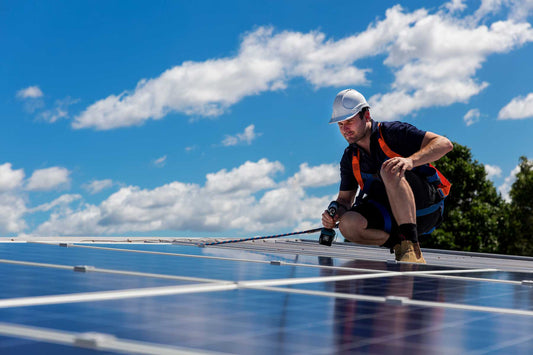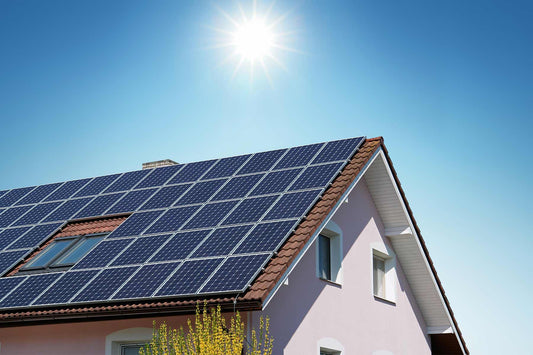Solar power is a renewable energy source derived from the sun. While solar energy is not “useful” in its raw form, it can be converted into usable electricity using solar technology such as photovoltaics (PV), concentrating solar-thermal power (CSP), and solar heating and cooling (SHC).
With 173,000 terawatts — or 10,000 times the amount of energy the entire world uses from moment to moment — of solar energy reaching the Earth’s surface at all times, there isn’t a richer source of energy on Earth. It makes sense why more homes and organizations have started transitioning to solar power solutions in recent years.
But what exactly is solar power, and how is it used? In this piece, we discuss everything you should know about this energy source, from its origin to its use to its future. You’ll be a solar power expert in no time.
Table of contents:
- What Is Solar Power?
- How Is Solar Power Captured?
- Solar Power Integration
- The Origin of Solar Energy
- The Cost of Solar Power
- The Future of Solar Power
- Solar Power FAQ
What Is Solar Power?
Solar power is a renewable energy source that is produced when energy from the sun’s rays (electromagnetic radiation) is converted into electricity. Essentially, solar power technology turns sunlight into useful forms of energy so that we can power our machines and appliances.
Solar energy is the cleanest and most widely available source of energy on Earth. That said, every part of the world receives a different amount of sunlight, making solar power generation easier in some places than others.
How Is Solar Power Captured?
The three most common ways to generate solar power include photovoltaics (PV), concentrating solar-thermal power (CSP), and solar heating and cooling (SHC). Let’s dive into each of these in greater detail.
Photovoltaics (PV)
When you think of solar power, your mind probably paints a picture of a solar panel adorned with several square-shaped cells. This form of solar energy collection is called photovoltaics, or PV, and it’s the most common way to collect solar energy.
PV cells are composed of semiconductor materials — the same type of materials used in computer chips. When sunlight makes contact with these cells, the cells’ electrons are released and their movement generates electricity.
Solar panels are employed in a variety of ways, from residential rooftop solar panels to large solar farms that power entire organizations and communities.
Concentrating Solar-Thermal Power (CSP)
CSP uses a different strategy to capture solar energy, angling mirrors to direct and concentrate the sun’s thermal energy to activate steam turbines. These turbines then generate electricity that is transported to the grid.
Since this method is best used in areas of high solar radiation, the U.S. Southwest is typically home to CSP plants.
It’s important to note that solar power isn’t just collected on the roofs of homes — it can also be generated at “utility scale,” providing significant amounts of energy to the electric grid. PV and CSP are two of the most popular solar energy collection methods built at utility scale.
Solar Heating and Cooling (SHC)
SHC, much like CSP, channels the sun’s thermal energy. That said, its use is a bit more specific, essentially just revolving around temperature.
Rather than directing the sun’s heat to a steam turbine, SHC collects thermal energy from the sun to generate hot water, to heat pools, and to provide space heating and cooling. This technology can provide a huge percentage (if not all) of any home or organization’s hot water needs.
Solar Power Integration
Solar collection technology is a critical part of harnessing and using solar energy, but it’s only the first step. Once solar power is collected, it needs to be integrated into homes, organizations, and electrical grids.
The Electrical Grid
The electrical grid is a complex system of energy sources, inverters, transformers, and energy storage systems, all connected by power lines to places that use electricity.
The grid can be broken down into two categories:
- Transmission grid: The transmission grid transports electricity from power plants across very large distances, using high-voltage lines to minimize power loss.
- Distribution grid: The distribution grid transports electricity from the grid to homes and organizations across short distances using low-voltage lines.
While the grid used to only travel in one direction — from power plants to the consumer — it now accommodates both directions. Residential solar panels that generate excess energy can now add that energy back to the grid via programs such as net metering.
Power Electronic Devices
Power electronic devices convert energy between forms. For example, solar cells generate direct current (DC), whereas home appliances tend to require alternating current (AC) to function.
That’s where inverters come in — a common power electronic device that converts DC to AC and vice versa, allowing for energy to flow seamlessly between energy sources (like solar panels), homes and organizations, and the grid.
The Origin of Solar Energy Use
Solar power is hugely popular today, but where did this technology begin?
The first time solar power became a viable way to sustainably power anything was way back in 1954, when Bell Labs (now a research arm of Nokia) produced the first silicon PV cell.
When solar cells were first developed, they were only operating at 4% efficiency. Today, many solar panels boast efficiency ratings of over 20%. As solar technology advances, this number is only increasing.
In recent years, solar power has become more widely adopted. This is largely thanks to governmental support and initiatives, the most prominent being the Federal Solar Investment Tax Credit (ITC), which we’ll discuss in greater detail in the following section.
The Cost of Solar Power
The cost of solar power has fallen dramatically over the years, dropping over 60% in the past decade, and the federal government has taken steps to make solar power even more affordable.
The ITC, which deducts 30% of the total cost to install a solar system from your federal taxes, will remain in effect through 2032.
On average, a complete solar panel installation costs between $2.50 and $3.50 per watt or between $12,000 and $30,000 total before incentives are applied. Installing solar panels as a DIY project (as opposed to a contractor or turnkey installation) can reduce this cost significantly, as solar panels themselves cost around $0.70 to $1.50 per watt.
The Future of Solar Power
With how sustainable and powerful it is, it should come as no surprise that solar power is becoming more popular and advanced every day. Below, we unpack how we can expect solar technology — and related tech — to improve in the coming years.
Solar Panels
While average solar panel efficiency falls in the 15% to 20% range, the past few years have brought about massive efficiency leaps, shedding light on what we’re capable of and where we’re heading.
By the end of 2015, the highest-efficiency solar cells were at 22.8% efficiency. By 2020, that number had risen to 47.1%. As a result, we’re seeing solar providers develop panels with previously unheard-of wattages, even approaching 700 W (a massive leap from the average 325 W).
In short, we can expect to see incredibly powerful solar technology become widely available as time goes on.
Other Technology
As a result of solar power’s development, other technologies are also advancing.
Since solar panels can only generate electricity during the day (and often generate far more than can be used right at that moment), energy storage solutions are needed to hold onto unused energy for later use. For this reason, battery storage solutions are expected to advance alongside solar energy.
Yet another industry growing alongside solar energy is electric vehicles (EV). By 2025, plug-in vehicles are projected to compose 23% of new passenger vehicle sales. That’s a 13% increase from 2021.
Since EVs need to be charged, their rise is accompanied by advancing charging tech. Solar-powered charging stations are growing in popularity, with Electrify America already adding over 30 solar-powered charging stations to rural California.
Solar Power FAQ
Widespread use of solar power is relatively new, and there’s a lot to understand about this renewable energy source. We address some common questions about the topic below.
Where Does Solar Power Come From?
There is only one source of solar energy — the sun. That energy is then captured by solar panels and other forms of solar technology (like CSP and SHC) to produce the electricity we use to power our appliances and devices.
Is Solar Energy Renewable?
Yes, solar energy is renewable. This is because it comes from the sun, which is projected to be around and produce energy for 5 billion more years.
Is Solar Power As Good As Electricity?
Solar power is electricity, once it’s collected by technology like solar panels or CSP. It’s just derived from the sun, whereas most of the grid’s electricity is currently derived from fossil fuels.
Solar power produced by rooftop panels is actually better than electricity pulled from the grid, as it can reduce electricity loss.
Solar panels are usually installed in close proximity with the home or organization using them, meaning the electricity has less distance to travel than electricity from the grid. The less distance electricity must travel, the less opportunity there is for it to be lost.
Is Solar Cheaper Than Electricity?
Yes — in the long run, generating your own solar is significantly cheaper than paying your utility company monthly for electricity.
While a solar system can have a pretty high upfront cost, it will likely pay for itself in less than half of its lifetime, meaning you’ll be generating over 10 years of “free” energy once it’s paid off.
Give our solar cost calculator a try to see how long it would take you to pay off your solar system.
Whereas most solar systems cost a premium that may cause sticker shock, Solartap keeps its upfront cost significantly lower than the competition, making solar power more accessible than ever.
Check out our residential solar panel offerings today, or get a quote using our solar calculator.




